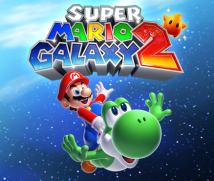6. This Time It’s Really Fun
Lastly, I’d like you to point out key aspects of the game for our customers. Hayashida-san, we’ll start with you.
Just like last time, two people can play cooperatively .
I’ve heard that there are more things to do this time for two players. Can you elaborate?
There’s a character called Co-Star Luma this time.
The one at the upper right-hand corner of the logo , right?
Yes. Last time, the second player could only stop an enemy, but this time, while you’re stopping an opponent, you can shake the Wii Remote to defeat that enemy.
You mean, the player with the second Wii Remote can also defeat enemies?
Yes. This time, players will feel more like they are having an adventure together.
And Co-Star Luma can follow along behind Mario carrying coins. When you hold down the A Button, Co-Star Luma will carry a coin, but if Mario suffers damage and you let go of the A Button, you get the coin and restore the Life Meter . And what’s more, Co-Star Luma can bring Mario 1-Up Mushrooms , so if you’ve got two players, you don’t have to stick out your own neck to get a 1-Up Mushroom.
I want players to enjoy cooperative play like that, but I think when people are playing with their family, they’ll want to make their own file and play Mario by themselves. And since there will be people who can’t move forward on their own, we created the Star Bank, which allows you to take Star Bits from a file where lots have been stored up and give them to another file.
So you would like family members to take turns playing.
That’s right. I thought it would be great if family members communicated with each other through the Star Bank. I myself always get home late at night, but my children have been playing during the day, so…
When you get home at night, you would get Star Bits from them.
Yep! (laughs) I would be happy if everyone enjoys such things, including cooperative play, together with their family members.
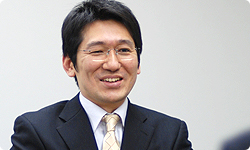
I see. How about you Hayakawa-san?
From the viewpoint of a programmer, I’d say we made this game based on our many years making action games as well as on a full understanding of the potential of the Wii hardware. The result is that it moves at 60 frames per second and it doesn’t take long to load, yet I nevertheless wanted the visuals to look stunning.
As a programmer, you would like players to see a good balance of such elements as good-looking visuals and short loading times.
Right. We were able to achieve that because of the general effort of the team. There’s quite a lot at even the most unexceptional places. For example, if you jump at even the most inconspicuous spot, another planet’s gravity might catch you, and you’ll go there by shortcut. There’s a lot there to be enjoyed, so I want players to try out all kinds of things in the game world and enjoy discovering everything in it, rather than just trying to finish the game.
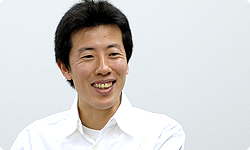
You’re next, Motokura-san.
Regarding design, the last game was a mysterious universe across which Mario had an adventure, but this time it’s more like a blue sky.
Last time, there was a deep blue, space-like universe with Mario flying in front of it, but this time it’s a light, blue sky and Mario.
That’s right. That was one of our themes from early on in development. Then Yoshi came in, and I knew players would be able to enjoy a world different from that of the previous game. And if you get tired of adventuring, you can go back to Starship Mario and take a breather.
Starship Mario is a place where you can take it easy.
Right. You’ve got a nice view of a star-filled sky and Starship Mario journeys across the universe to different environments, so I hope players will enjoy those types of changes, too. And one more thing. Lots of different galaxies show up this time, but stages like Whomp’s Fortress in Mario 64 and galaxies based on past games in the series also show up, so I hope players will pay attention to that.
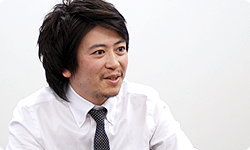
For example, in the Supermassive Galaxy, a giant Goomba comes out. That is based on material in Mario 316 and Mario 64. 16Super Mario Bros. 3: A platform game released for the NES system in Europe in August 1991.
And one stage resembles Mario Sunshine.
There are lots of elements recognisable to fans, so you want them to remember their experiences with past games when they play those stages. And last, Koizumi-san.
As producer, something I told the development staff over and over again was to make the game seriously and with consideration. I told them that because I learned the hard way with the last game that 3D games ask a lot of players.
To me, it seems like this game was made with even more consideration than the last one. Does that mean that you made an effort this time to cut down as much as possible on the people who start playing and then say “I can’t keep up”?
Yes. We wanted to make something that anyone could play, but there were some players who wanted something a little more challenging.
Those don’t quite go together, making it more challenging and making it so anyone can play it.
We pursued those two opposing themes this time, but we called it Super Mario Galaxy 2, so, to put it in terms of a musical instrument like we discussed earlier, I think it turned out to be a game that allows gamers to enjoy playing sophisticated music and enjoy a wider variety of songs. This game is, however, also made to be more friendly to beginners than the last game, so rather than reject it without trying it, I hope as many people as possible will give it a try.
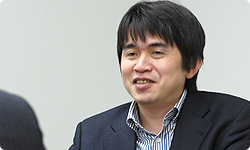
I see. As for me, something that really struck me this time was that, while it goes without saying that Miyamoto-san’s games are always fun, Miyamoto-san went out of his way to tell me that this time the game is really fun.
Really?!
He rarely says that.
It was quite a good feeling to hear that. Miyamoto-san doesn’t usually say that kind of thing. That he told me that must mean that it really struck a chord with him. I think it’s the high concentration of ideas that made him say it.
Maybe he feels like we took care of some of his own homework left over from last time.
It seems to have lightened him incredibly to have had that heart-to-heart with you and cleared up problems that had gone unaddressed for ten years.
By talking with him, I learned the importance of resonance. It’s just a single word, but it is an important and deeply meaningful word that cannot easily be summarised.
So you’d be happy if lots of people play the game and find that it resonates with them. Thank you for your time today.
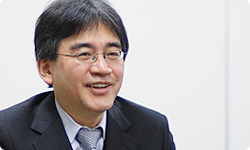
Thank you for coming.
